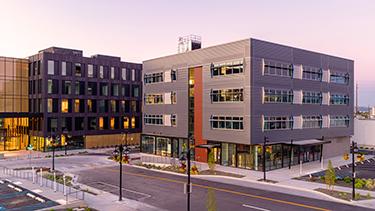|
Subscribe / Renew |
|
|
Contact Us |
|
| ► Subscribe to our Free Weekly Newsletter | |
| home | Welcome, sign in or click here to subscribe. | login |
Real Estate
| |
 |
May 27, 2021
The many shades of green
McKinstry

Cochrane
|
Mandatory building energy performance is now Washington state law, and many building owners may be surprised by the stringency of compliance requirements. Perhaps most surprising to many in the real estate industry, however, is that Washington’s first-in-the-nation law is really not so innovative when compared with changes driven by the private sector. Specifically, global capital markets are now factoring climate-change risk mitigation into investment criteria, affecting every phase of the building lifecycle and every aspect of the building industry.
LEADING THE WAY
The Washington Clean Buildings Act (CBA) was signed into law during the 2019 legislative session, establishing mandatory energy performance targets for all non-residential buildings larger than 50,000 square feet. HB 1257 authorizes the Department of Commerce to develop energy use intensity (EUI) targets set at 15% less than the Washington state average for each building use type (mixed-use buildings are required to provide aggregated EUI).
Building owners will be required to demonstrate compliance starting in 2026 by verifying energy performance and presenting a comprehensive Energy Management Plan and Operations & Maintenance Plan. Penalties for noncompliance include $1 per square foot fines assessed annually — potentially, hundreds of thousands of dollars for some buildings if all compliance requirements are not met. This is the most aggressive state legislation focused on energy efficiency in the country.
Locally, the Seattle City Council last year adopted code requirements that restrict natural gas use in new multifamily and commercial buildings, a move that will require much of the city’s future construction to convert heating systems to electric power. The electrification requirements extend to alterations and replacements of existing commercial buildings — any upgrade or replacement that triggers Seattle Energy Code compliance will require phasing out of fossil-fuel based equipment.
Most recently, the Legislature passed Senate Bill 5126, the Climate Commitment Act, which is headed to Gov. Inslee’s desk to be signed into law. This legislation will create a cap-and-invest program — through a binding limit across all major sectors of the economy — to reduce greenhouse gas emissions from the largest emitters in the state. It will also invest in programs and projects that reduce emissions, expand clean transportation, improve climate resiliency and reduce air pollution.
For the real estate sector, the writing is no longer on the wall, it’s in the law — building energy performance is now capped and requires verification, and fossil fuel consumption will be dramatically curtailed.
ACT LOCALLY
The intent of the CBA is to lower costs and pollution from fossil fuel consumption in the state’s existing building stock, especially large commercial buildings. Buildings account for 27% of Washington’s greenhouse-gas emissions. They are the fastest growing and second largest source of emissions — up 50% since 1990 — and commercial buildings make up approximately half of these emissions.
Opponents of the legislation — and even many who support reductions in greenhouse gas emissions — express concern that the CBA is an unfunded mandate that, like energy codes and other constraints, will reduce affordability and add to the financial burdens of real estate developers, owners and managers.
However, opponents overlook the trends shaping global real estate and financial markets — namely, the fact that climate change is a determining factor in global capital allocations, which directly affects how money flows to all asset classes including real estate. This position focuses less on mitigating climate change as an environmental imperative and more on the financial risks and rewards of both preparing for instability brought on by climate change and being part of the mitigation solution.
At first glance, the drivers of this change may appear to be based in sustainability initiatives, most evident in the race by large technology companies to reach zero-carbon or carbon neutrality within aggressive timelines. Increasingly, capital markets and firms in every industry are adopting ESG (environmental, social and corporate governance) criteria or strategies to guide investments. ESG refers to the three factors used to measure the sustainability and societal impacts of an investment, with focus on the ability of a company to create value over the long-term.
However, an equal if not greater force affecting investments is the very real threat of risk and financial instability caused by climate change. Companies that do not have a plan to adapt to instability or to be part of climate change mitigation are now considered higher risk than those that have plans and are taking steps toward reducing greenhouse gas emissions — that is, reducing instability and therefore risk.
If you follow the money, the global bets are being placed on business activities that reduce fossil fuel consumption and greenhouse gas emissions reductions. The Task Force on Climate-Related Financial Disclosures, chaired by Michael Bloomberg, issued a 2017 report that emphasized the importance of transparency in pricing risk — including risk related to climate change — to support informed, efficient capital-allocation decisions.
By 2020, support for the TFCF recommendations grew to 1,500 organizations globally, including more than 1,340 companies with a market capitalization of $12.6 trillion and financial institutions responsible for assets of $150 trillion. In fact, a $9 billion real estate portfolio was recently turned away by a large European pension fund because it did not have a climate-change mitigation plan (or a building decarbonization plan) in place.
Globally, the money is flowing to assets and investments that are taking action to address climate change.
FOCUS ON OPPORTUNITY
Closer to home, the global shift in capital aligns well with local regulatory mandates to present opportunities for the real estate sector. The short-term inconveniences of mandated changes in building performance and energy sources are small compared to the financial benefits of transition. And the upshot for the real estate industry is twofold.
First, as penalties for carbon and greenhouse gas emissions increase, capital will flow toward stable, lower risk assets. Buildings that burn fossil fuels are already being considered higher risk assets, and as with fossil fuel-based power generation systems, buildings and portfolios without plans to convert to electricity are being categorized as future stranded assets.
Second, electrification of the built environment is an opportunity for building owners to capture new value streams through participation in an intelligent energy system. Although the CBA is ostensibly an energy efficiency mandate, the state has made no secret of the intent to shift from EUI to greenhouse gas metrics. The outdated power grid — think centralized generation and inefficient distribution — is transitioning (however slowly) to a more intelligent, efficient, distributed system that includes local generation and storage. All-electric buildings can participate in a new transactive energy system. Enhanced power stability, reliability, and resilience are the financial realities of a decarbonized built environment. In many ways, the actions of state and local leaders to reduce climate impacts from the built environment presents a competitive advantage for building owners.
The building sector is slow to change, but developers and owners that invest in decarbonization will immediately be better positioned to attract capital and reap the benefits of reduced insurance premiums, long-term asset value, and competitive market advantage. Washington state is once again a national leader in environmental policy, and the real estate industry should embrace change for what it is: future-proofing the built environment to make our regional economy stable and resilient for the long term.
Ric Cochrane is McKinstry’s Clean Buildings Act specialist.
Other Stories:
- Coming soon: A surge of TODs in the Bel-Red corridor
- Regional growth: Towns, small cities should choose to lead or be led
- Our city, our time
- Sustainable urban design: connecting community and nature
- Placemaking in pocket parks: Sustaining authenticity in growing urban neighborhoods
- Little houses everywhere: How ADUs will reshape the urban fabric
- Coming soon: A surge of TODs in the Bel-Red corridor
- Making changes that last generations
- Diverse spaces are key to returning urban cores to normal
- Preparing for Bellevue’s dynamic future
- Infinity Shore Club shows resilience of Seattle market
- Meeting the SE 2050 Challenge



